Spatial and Temporal Evolution Assessment of Landscape Ecological Resilience Based on Adaptive Cycling in Changsha–Zhuzhou–Xiangtan Urban Agglomeration, China
Abstract
:1. Introduction
2. Materials and Methods
2.1. Study Area
2.2. Data Sources and Processing
2.3. Research Methodology
2.3.1. Indicators of Landscape Ecological Resilience
2.3.2. Landscape Ecological Resilience
2.3.3. Adaptive Cycling Stages
2.3.4. Moran’s Index
2.3.5. Geodetector Model
3. Results
3.1. Assessment of Landscape Ecological Resilience Indicators
3.2. Analysis of Spatial Heterogeneity of Landscape Ecological Resilience
3.2.1. Trends in the Spatial and Temporal Evolution of Landscape Ecological Resilience
3.2.2. Landscape Ecological Resilience Spatial Association Patterns
3.2.3. Drivers of Spatial Differentiation in Landscape Ecological Resilience
3.3. Adaptive Cycle Stage Identification
3.3.1. Analysis of the “Potential-Connectivity-Resilience” Eigenvalue
3.3.2. Adaptation Stage Identification
4. Discussion
4.1. Resilience Analysis of Different Land Use
4.2. Adaptive Strategies for Landscape Ecological Resilience in Urban Clusters
4.3. Limitations and Recommendations of This Study
5. Conclusions
Author Contributions
Funding
Data Availability Statement
Acknowledgments
Conflicts of Interest
References
- Itsukushima, R.; Ohtsuki, K. A century of stream burial due to urbanization in the Tokyo Metropolitan Area. Environ. Earth Sci. 2021, 80, 237. [Google Scholar] [CrossRef]
- Lu, Z.; Zhang, M.; Hu, C.; Ma, L.; Chen, E.; Zhang, C.; Xia, G. Spatiotemporal Changes and Influencing Factors of the Coupled Production–Living–Ecological Functions in the Yellow River Basin, China. Land 2024, 13, 1909. [Google Scholar] [CrossRef]
- Keyes, A.A.; McLaughlin, J.P.; Barner, A.K.; Dee, L.E. An ecological network approach to predict ecosystem service vulnerability to species losses. Nat. Commun. 2021, 12, 1586. [Google Scholar] [CrossRef]
- Holling, C.S. Adaptive Environmental Assessment and Management; John Wiley: Toronoto, ON, USA, 1978. [Google Scholar]
- Adger, W.N.; Hughes, T.P.; Folke, C.; Carpenter, S.R.; Rockstrom, J. Social ecological resilience to coastal disasters. Science 2005, 309, 1036–1039. [Google Scholar] [CrossRef]
- Holling, C.S. Resilience and stability of ecological systems. Annu. Rev. Ecol. Evol. Syst. 1973, 4, 1–23. [Google Scholar]
- Liang, J.; Zhang, M.; Yin, Z.; Niu, K.; Li, Y.; Zhi, K.; Huang, S.; Yang, J.; Xu, M. Tripartite evolutionary game analysis and sim-ulation research on zero-carbon production supervision of marine ranching against a carbon-neutral background. Front. Ecol. Evol. 2023, 11, 1119048. [Google Scholar]
- Ostrom, E. Panarchy: Understanding transformations in human and natural systems. Ecol. Econ. 2004, 49, 488–491. [Google Scholar]
- Schrenk, H.; Garcia-Perez, C.; Schreiber, N.; Castell, W.Z. QtAC: An R-package for analyzing complex systems development in the framework of the adaptive cycle metaphor. Ecol. Model. 2022, 466, 109860. [Google Scholar] [CrossRef]
- Gotts, N.M. Resilience, panarchy, and world-systems analysis. Ecol. Soc. 2007, 12, 181–194. [Google Scholar]
- Zhang, M.; Tan, S.; Chen, E.; Li, J. Spatio-temporal characteristics and influencing factors of land disputes in China: Do so-cio-economic factors matter? Ecol. Indic. 2024, 160, 111938. [Google Scholar] [CrossRef]
- Zhao, R.; Fang, C.; Liu, J.; Zhang, L. The evaluation and obstacle analysis of urban resilience from the multidimensional perspective in Chinese cities. Sustain. Cities Soc. 2022, 86, 104160. [Google Scholar] [CrossRef]
- Zhang, S.; Zhu, H.; Zeng, K.; Zhang, Y.; Jin, Z.; Wang, Y.; Zhang, R.; Jürgen, B.; Liu, M. From city to countryside: Unraveling the long-term complex effects of urbanization on vegetation growth in China. J. Environ. Manag. 2025, 380, 124975. [Google Scholar] [CrossRef]
- Liu, L.; Lei, Y.; Zhuang, M.; Ding, S. The impact of climate change on urban resilience in the Beijing-Tianjin-Hebei region. Sci. Total Environ. 2022, 827, 154157. [Google Scholar] [CrossRef] [PubMed]
- Ning, X.; Zhang, X.; Zhang, X.; Wang, H.; Zhang, W. A Method for Assessing Urban Ecological Resilience and Identifying Its Critical Distance Belt Based on the “Source-Sink” Theory: A Case Study of Beijing. Remote Sens. 2023, 15, 2502. [Google Scholar] [CrossRef]
- Zhang, M.; Chen, E.; Zhang, C.; Liu, C.; Li, J. Multi-Scenario Simulation of Land Use Change and Ecosystem Service Value Based on the Markov–FLUS Model in Ezhou City, China. Sustainability 2024, 16, 6237. [Google Scholar] [CrossRef]
- Chao, W.; Yuan, S.; Zhi, J. Urban landscape sustainability in karst mountainous cities: A landscape resilience perspective. Heliyon 2024, 10, e31651. [Google Scholar] [CrossRef]
- Cao, Q.; Huang, Y.; Ran, B.; Zeng, G.; Van Rompaey, A.; Shi, M. Coordination Conflicts between Urban Resilience and Urban Land Evolution in Chinese Hilly City of Mianyang. Remote Sens. 2021, 13, 4887. [Google Scholar] [CrossRef]
- Wu, X.; Zhang, J.; Geng, X.; Wang, T.; Wang, K.; Liu, S. Increasing green infrastructure-based ecological resilience in urban systems: A perspective from locating ecological and disturbance sources in a resource-based city. Sustain. Cities Soc. 2020, 61, 102354. [Google Scholar] [CrossRef]
- Zhang, H.; Liu, Y.; Li, J.; Tian, P.; Zhong, J.; Gong, H. Evaluation and analysis of coastal complex ecological resilience based on multidimensional data: A case study of East China Sea. Ecol. Indic. 2023, 155, 110981. [Google Scholar] [CrossRef]
- Lin, Y.; Peng, C.; Chen, P.; Zhang, M. Conflict or synergy? Analysis of economic-social- infrastructure-ecological resilience and their coupling coordination in the Yangtze River economic Belt, China. Ecol. Indic. 2022, 142, 109194. [Google Scholar] [CrossRef]
- Wang, K.; Ma, H.; Fang, C. The relationship evolution between urbanization and urban ecological resilience in the Northern Slope Economic Belt of Tianshan Mountains, China. Sustain. Cities Soc. 2023, 97, 104783. [Google Scholar] [CrossRef]
- Nathwani, J.; Lu, X.; Wu, C.; Fu, G.; Qin, X. Quantifying security and resilience of Chinese coastal urban ecosystems. Sci. Total Environ. 2019, 672, 51–60. [Google Scholar] [CrossRef] [PubMed]
- Rumson, A.G.; Garcia, A.P.; Hallett, S.H. The role of data within coastal resilience assessments: An East Anglia, UK, case study. Ocean Coast. Manag. 2020, 185, 105004. [Google Scholar] [CrossRef]
- Wang, S.; Li, Z.; Long, Y.; Yang, L.; Ding, X.; Sun, X.; Chen, T. Impacts of urbanization on the spatiotemporal evolution of ecological resilience in the Plateau Lake Area in Central Yunnan, China. Ecol. Indic. 2024, 160, 111836. [Google Scholar] [CrossRef]
- Falk, D.A.; Van Mantgem, P.J.; Keeley, J.E.; Gregg, R.M.; Guiterman, C.H.; Tepley, A.J.; JN Young, D.; Marshall, L.A. Mechanisms of forest resilience. For. Ecol. Manag. 2022, 512, 120129. [Google Scholar] [CrossRef]
- Li, B.; Li, X.; Liu, C. Dynamic evolution of the ecological resilience and response under the context of carbon neutrality. Ecosyst. Health Sustain. 2022, 9, 0130. [Google Scholar] [CrossRef]
- Zhang, S.; Lei, J.; Tong, Y.; Zhang, X.; Lu, D.; Fan, L.; Duan, Z. Temporal and spatial responses of ecological resilience to climate change and human activities in the economic belt on the northern slope of the Tianshan Mountains, China. J. Arid Land 2023, 15, 1245–1268. [Google Scholar] [CrossRef]
- Meng, Z.; He, M.; Li, X.; Li, H.; Tan, Y.; Li, Z.; Wei, Y. Spatio-temporal analysis and driving forces of urban ecosystem resilience based on land use: A case study in the Great Bay Area. Ecol. Indic. 2024, 159, 111769. [Google Scholar] [CrossRef]
- Zhang, C.; Zhou, Y.; Yin, S. Interaction mechanisms of urban ecosystem resilience based on pressure-state-response framework: A case study of the Yangtze River Delta. Ecol. Indic. 2024, 166, 112263. [Google Scholar] [CrossRef]
- Xu, C.; Huo, X.; Hong, Y.; Yu, C.; De Jong, M.; Cheng, B. How urban greening policy affects urban ecological resilience: Quasi-natural experimental evidence from three megacity clusters in China. J. Clean. Prod. 2024, 452, 142233. [Google Scholar] [CrossRef]
- Zhao, R.; Fang, C.; Liu, H.; Liu, X. Evaluating urban ecosystem resilience using the DPSIR framework and the ENA model: A case study of 35 cities in China. Sustain. Cities Soc. 2021, 72, 102997. [Google Scholar] [CrossRef]
- Lee, C.; Yan, J.; Li, T. Ecological resilience of city clusters in the middle reaches of Yangtze river. J. Clean. Prod. 2024, 443, 141082. [Google Scholar] [CrossRef]
- Huang, J.; Zhong, P.; Zhang, J.; Zhang, L. Spatial-temporal differentiation and driving factors of ecological resilience in the Yellow River Basin, China. Ecol. Indic. 2023, 154, 110763. [Google Scholar] [CrossRef]
- Li, H.; Wang, Y.; Zhang, H.; Yin, R.; Liu, C.; Wang, Z.; Fu, F.; Zhao, J. The spatial-temporal evolution and driving mechanism of Urban resilience in the Yellow River Basin cities. J. Clean. Prod. 2024, 447, 141614. [Google Scholar] [CrossRef]
- Tong, Y.; Lei, J.; Zhang, S.; Zhang, X.; Rong, T.; Fan, L.; Duan, Z. Analysis of the Spatial and Temporal Variability and Factors Influencing the Ecological Resilience in the Urban Agglomeration on the Northern Slope of Tianshan Mountain. Sustainability 2023, 15, 4828. [Google Scholar] [CrossRef]
- Yaermaimaiti, A.; Li, X.; Ge, X.; Liu, C. Analysis of landscape pattern and ecological risk change characteristics in Bosten Lake basin based on optimal scale. Ecol. Indic. 2024, 163, 112120. [Google Scholar] [CrossRef]
- Wang, D.; Wang, P.; Chen, G.; Liu, Y. Ecological–social–economic system health diagnosis and sustainable design of high-density cities: An urban agglomeration perspective. Sustain. Cities Soc. 2022, 87, 104177. [Google Scholar] [CrossRef]
- Javier, A.B.; Claudio, P.; Guido, S.; Davide, G.; Thomas, E.; Benedetto, R. Modelling the net environmental and economic impacts of urban nature-based solutions by combining ecosystem services, system dynamics and life cycle thinking: An application to urban forests. Ecosyst. Serv. 2023, 60, 101506. [Google Scholar] [CrossRef]
- Li, W.; Wang, Y.; Xie, S.; Sun, R.; Cheng, X. Impacts of landscape multifunctionality change on landscape ecological risk in a megacity, China: A case study of Beijing. Ecol. Indic. 2020, 117, 106681. [Google Scholar] [CrossRef]
- Yan, Y.; Ju, H.; Zhang, S.; Chen, G. The Construction of Ecological Security Patterns in Coastal Areas Based on Landscape Ecological Risk Assessment—A Case Study of Jiaodong Peninsula, China. Int. J. Environ. Res. Public Health 2021, 18, 12249. [Google Scholar] [CrossRef]
- Peng, H.; Lou, H.; Yang, Y.; He, Q.; Liu, Y.; Chen, E.; Zhang, M. Spatial and Temporal Heterogeneity of Human- Air-Ground Coupling Relationships at Fine Scale. Pol. J. Environ. Stud. 2025, 20, 1–18. [Google Scholar] [CrossRef]
- Mentaschi, L.; Duveiller, G.; Zulian, G.; Corbane, C.; Pesaresi, M.; Maes, J.; Stocchino, A.; Feyen, L. Global long-term mapping of surface temperature shows intensified intra-city urban heat island extremes. Glob. Environ. Change 2022, 72, 102441. [Google Scholar] [CrossRef]
- Jing, P.; Zhang, D.; Ai, Z.; Guo, B. Natural landscape ecological risk assessment based on the three-dimensional framework of pattern-process ecological adaptability cycle: A case in Loess Plateau. Acta Ecol. Sin. 2021, 41, 7026–7036. [Google Scholar] [CrossRef]
- Das, M.; Das, A.; Mandal, A. Exploring the factors affecting urban ecological risk: A case from an Indian mega metropolitan region. Geosci. Front. 2022, 14, 101488. [Google Scholar] [CrossRef]
- Li, S.; He, W.; Wang, L.; Zhang, Z.; Chen, X.; Lei, T.; Wang, S.; Wang, Z. Optimization of landscape pattern in China Luojiang Xiaoxi basin based on landscape ecological risk assessment. Ecol. Indic. 2023, 146, 109887. [Google Scholar] [CrossRef]
- Chen, X.; Yang, Z.; Wang, T.; Han, F. Landscape Ecological Risk and Ecological Security Pattern Construction in World Natural Heritage Sites: A Case Study of Bayinbuluke, Xinjiang, China. ISPRS Int. J. Geo-Inf. 2022, 11, 328. [Google Scholar] [CrossRef]
- Li, X.; Li, S.; Zhang, Y.; O’Connor, P.J.; Zhang, L.; Yan, J. Landscape Ecological Risk Assessment under Multiple Indicators. Land 2021, 10, 739. [Google Scholar] [CrossRef]
- Zhao, Y.; Tao, Z.; Wang, M.; Chen, Y.; Wu, R.; Guo, L. Landscape Ecological Risk Assessment and Planning Enlightenment of Songhua River Basin Based on Multi-Source Heterogeneous Data Fusion. Water 2022, 14, 4060. [Google Scholar] [CrossRef]
- Bai, H.; Weng, L. Ecological security pattern construction and zoning along the China-Laos Railway based on the potential-connectedness-resilience framework. Ecol. Indic. 2023, 146, 109773. [Google Scholar] [CrossRef]
- Zhou, Y.; Zhao, X. Spatial relationship between human activity intensities and ecosystem services value in Changsha-Zhuzhou-Xiangtan urban agglomeration. China Environ. Sci. 2024, 44, 2948–2960. [Google Scholar]
- Xu, M.; Matsushima, H. Multi-dimensional landscape ecological risk assessment and its drivers in coastal areas. Sci. Total Environ. 2024, 908, 168183. [Google Scholar] [CrossRef] [PubMed]
- Peng, J.; Wang, Y.; Wu, J.; Shen, H.; Pan, Y. Research Progress on Evaluation Frameworks of Regional Ecological Sustainability. Chin. Geogr. Sci. 2011, 21, 496–510. [Google Scholar] [CrossRef]
- Tian, P.; Li, J.; Cao, L.; Pu, R.; Gong, H.; Liu, Y.; Zhang, H.; Chen, H. Impacts of reclamation derived land use changes on ecosystem services in a typical gulf of eastern China: A case study of Hangzhou bay. Ecol. Indic. 2021, 132, 108259. [Google Scholar] [CrossRef]
- Wang, C.; Han, L.; He, Y.; Zhang, Y.; Zhang, M. Analysis of Vegetation Restoration Potential and Its Influencing Factors on the Loess Plateau: Based on the Potential Realization Model and Spatial Dubin Model. Land 2025, 14, 138. [Google Scholar] [CrossRef]
- Lei, J.; Li, C.; Yang, W. Ecosystem health assessment and approaches to improve Sichuan Province based on an improved vigor organization resilience model. Ecol. Indic. 2023, 155, 110925. [Google Scholar] [CrossRef]
- Pan, Z.; He, J.; Liu, D.; Wang, J.; Guo, X. Ecosystem health assessment based on ecological integrity and ecosystem services demand in the Middle Reaches of the Yangtze River Economic Belt, China. Sci. Total Environ. 2021, 774, 144837. [Google Scholar] [CrossRef]
- Wang, Z.; Lin, L.; Zhang, B.; Xu, H.; Xue, J.; Fu, Y.; Zeng, Y.; Li, F. Sustainable urban development based on an adaptive cycle model: A coupled social and ecological land use development model. Ecol. Indic. 2023, 154, 110666. [Google Scholar] [CrossRef]
- Finch, D.; Corbacho, D.; Schofield, H.; Davison, S.; Wright, P.G.R.; Broughton, R.K.; Mathews, F. Modelling the functional connectivity of landscapes for greater horseshoe bats Rhinolophus ferrumequinum at a local scale. Landsc. Ecol. 2020, 35, 577–589. [Google Scholar] [CrossRef]
- Blazquez, C.S.; Ciudad, C.; Gaston, A.; Simon, M.; Saura, S. Identification of strategic corridors for restoring landscape connectivity: Application to the Iberian lynx. Anim. Conserv. 2019, 22, 210–219. [Google Scholar] [CrossRef]
- Mengist, W.; Soromessa, T.; Feyisa, G.L. Landscape change effects on habitat quality in a forest biosphere reserve: Implications for the conservation of native habitats. J. Clean. Prod. 2021, 329, 129778. [Google Scholar] [CrossRef]
- Wang, C.; Zhou, S.; Liu, H.; Li, Y. Robustness and its optimization of the habitat network structure for the multi guilds coexistence: A case study of Yancheng coastal wetlands. Acta Ecol. Sin. 2023, 43, 9193–9205. [Google Scholar] [CrossRef]
- Xie, J.; Xie, B.; Zhou, K.; Li, J.; Xiao, J.; Liu, C.; Zhang, X. Factors impacting ecological network in Changsha-Zhuzhou-Xiangtan urban agglomeration, China—Based on the perspective of functional performance. Ecol. Indic. 2023, 154, 110771. [Google Scholar] [CrossRef]
- Xu, Y.; Duan, J.; Xu, X. Comprehensive measure methods of regional multi-dimensional development and their applications. Acta Geogr. Sin. 2016, 71, 2129–2140. [Google Scholar] [CrossRef]
- Sundstrom, S.M.; Allen, C.R. The adaptive cycle: More than a metaphor. Ecol. Complex. 2019, 39, 100767. [Google Scholar] [CrossRef]
- Holling, C.S. Resilience of Ecosystems: Local Surprise and Global Change. In Sustainable Development and the Biosphere; Clark, W.C., Munn, R.E., Eds.; Cambridge University Press: Cambridge, UK, 1986. [Google Scholar]
- Zhang, M.; Kafy, A.-A.; Ren, B.; Zhang, Y.; Tan, S.; Li, J. Application of the Optimal Parameter Geographic Detector Model in the Identification of Influencing Factors of Ecological Quality in Guangzhou, China. Land 2022, 11, 1303. [Google Scholar] [CrossRef]
- Wang, J.; Xu, C. Geodetector: Principle and prospective. Acta Geogr. Sin. 2017, 72, 116–134. [Google Scholar] [CrossRef]
- Feng, X.; Xiu, C.; Bai, L.; Zhong, Y.; Wei, Y. Comprehensive evaluation of urban resilience based on the perspective of landscape pattern: A case study of Shenyang city. Cities 2020, 104, 102722. [Google Scholar] [CrossRef]
- Hu, C.; Zhang, M.; Huang, G.; Li, Z.; Sun, Y.; Zhao, J. Tracking the Impact of the Land Cover Change on the Spatial-Temporal Distribution of the Thermal Comfort: Insights from the Qinhuai River Basin, China. Sustain. Cities Soc. 2024, 18, 105916. [Google Scholar] [CrossRef]
- Sandoval, S.; Escobar-Flores, J.G.; Badar Munir, M. Urbanization and its impacts on land surface temperature and sea surface temperature in a tourist region in Mexico from 1990 to 2020. Remote Sens. Appl. Soc. Environ. 2023, 32, 101046. [Google Scholar] [CrossRef]
- Yang, H.; Ning, Q.; Zhou, H.; Lai, N.; Song, Q.; Ji, Q.; Zeng, Z. Digital research on the resilience control of water ecological space under the concept of urban-water coupling. Front. Environ. Sci. 2023, 11, 1270921. [Google Scholar] [CrossRef]
- Zhu, H.; Wang, A.; Wang, P.; Hu, C.; Zhang, M. Spatiotemporal Dynamics and Response of Land Surface Temperature and Kernel Normalized Difference Vegetation Index in Yangtze River Economic Belt, China: Multi-Method Analysis. Land 2025, 14, 598. [Google Scholar] [CrossRef]
- Kebede, A.S.; Nicholls, R.J.; Allan, A.; Arto, I.; Cazcarro, I.; Fernandes, J.A.; Hill, C.T.; Hutton, C.W.; Kay, S.; Lázár, A.N.; et al. Applying the global RCP–SSP–SPA scenario framework at sub-national scale: A multi-scale and participatory scenario approach. Sci. Total Environ. 2018, 635, 659–672. [Google Scholar] [CrossRef] [PubMed]
- Sun, Z.; Wang, S.; Chen, B. Construction of ecological security pattern and assessment of ecological resilience based on ecosystem services: A case study of Changsha-Zhuzhou-Xiangtan urban agglomeration. Acta Ecol. Sin. 2024, 44, 4650–4661. [Google Scholar]
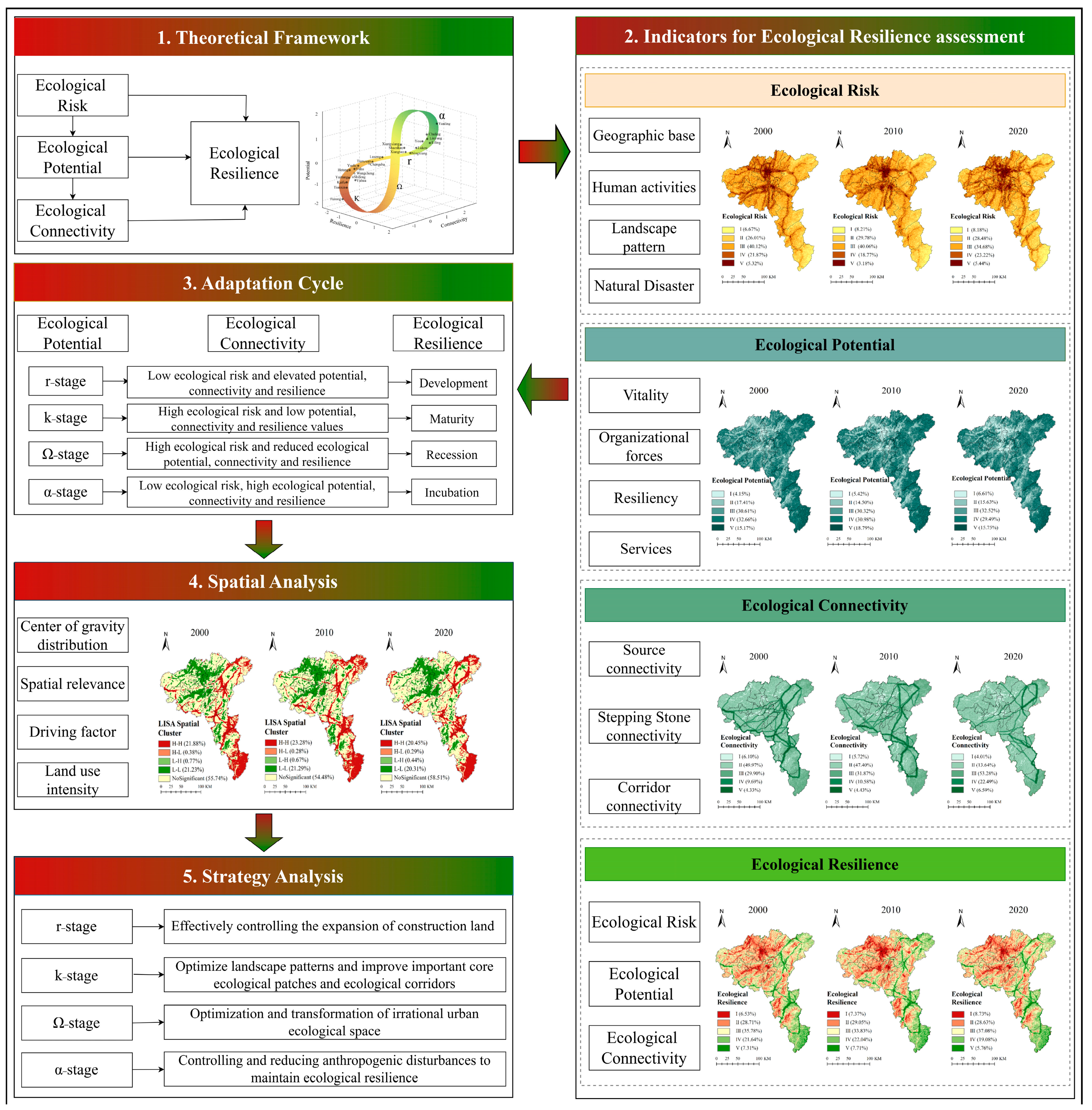



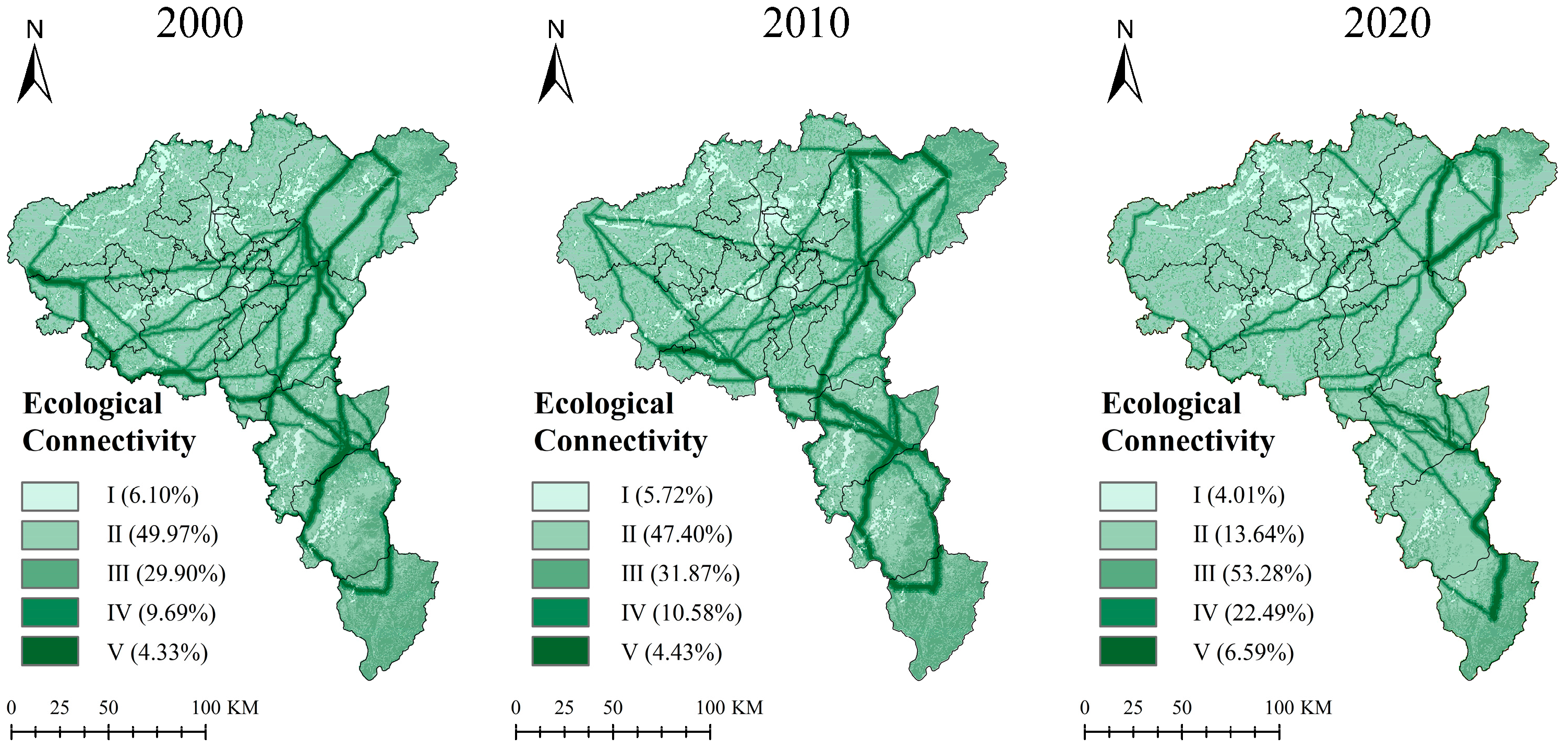
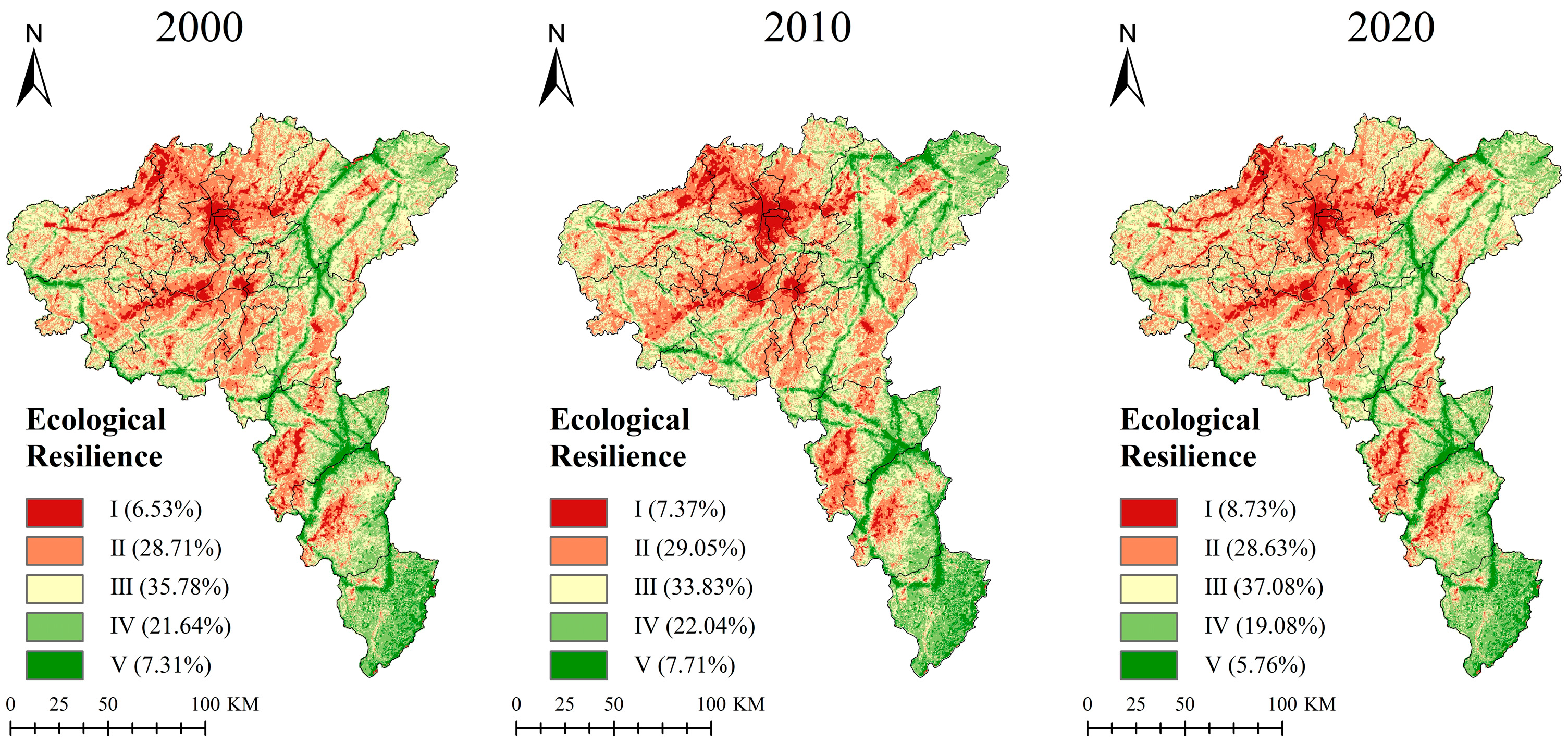

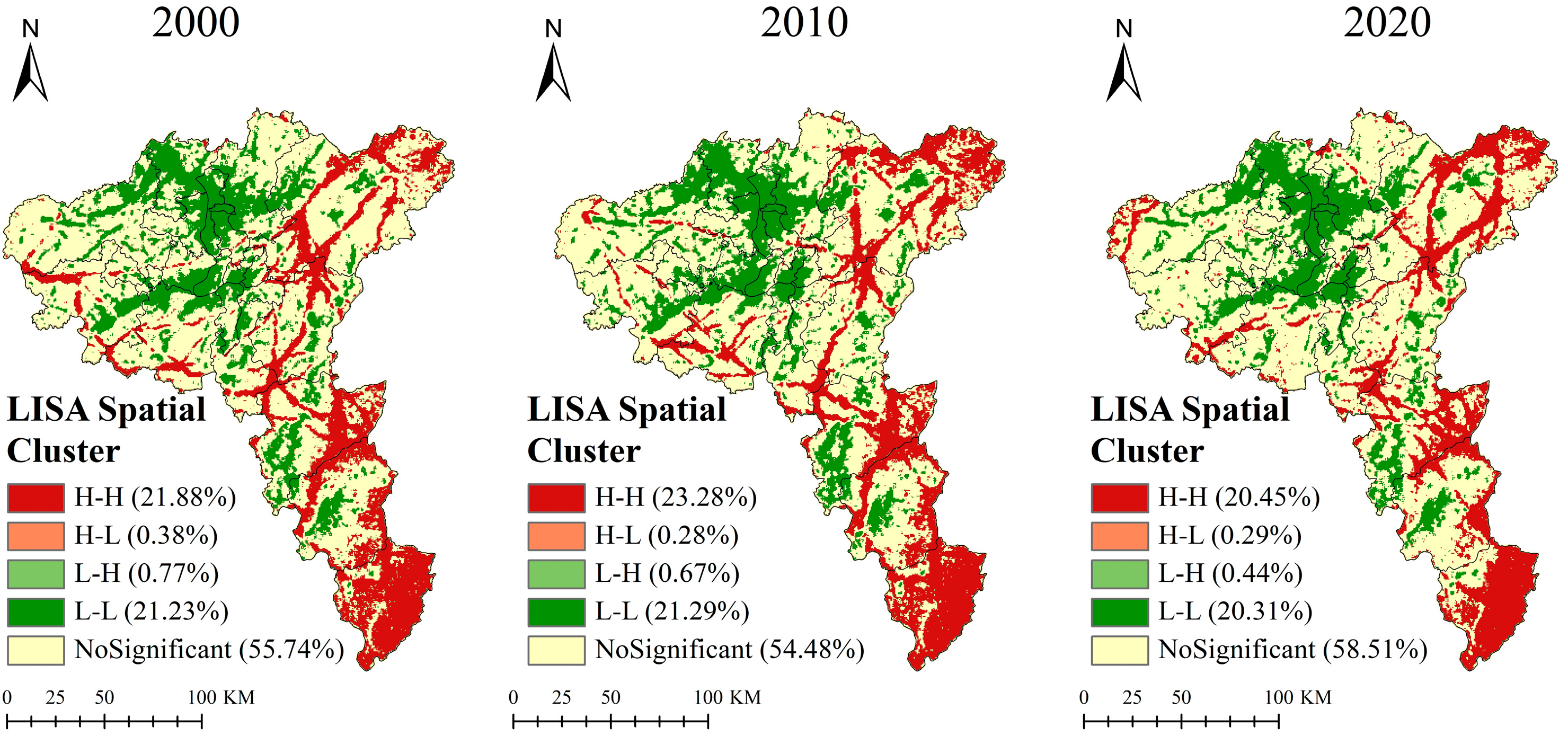

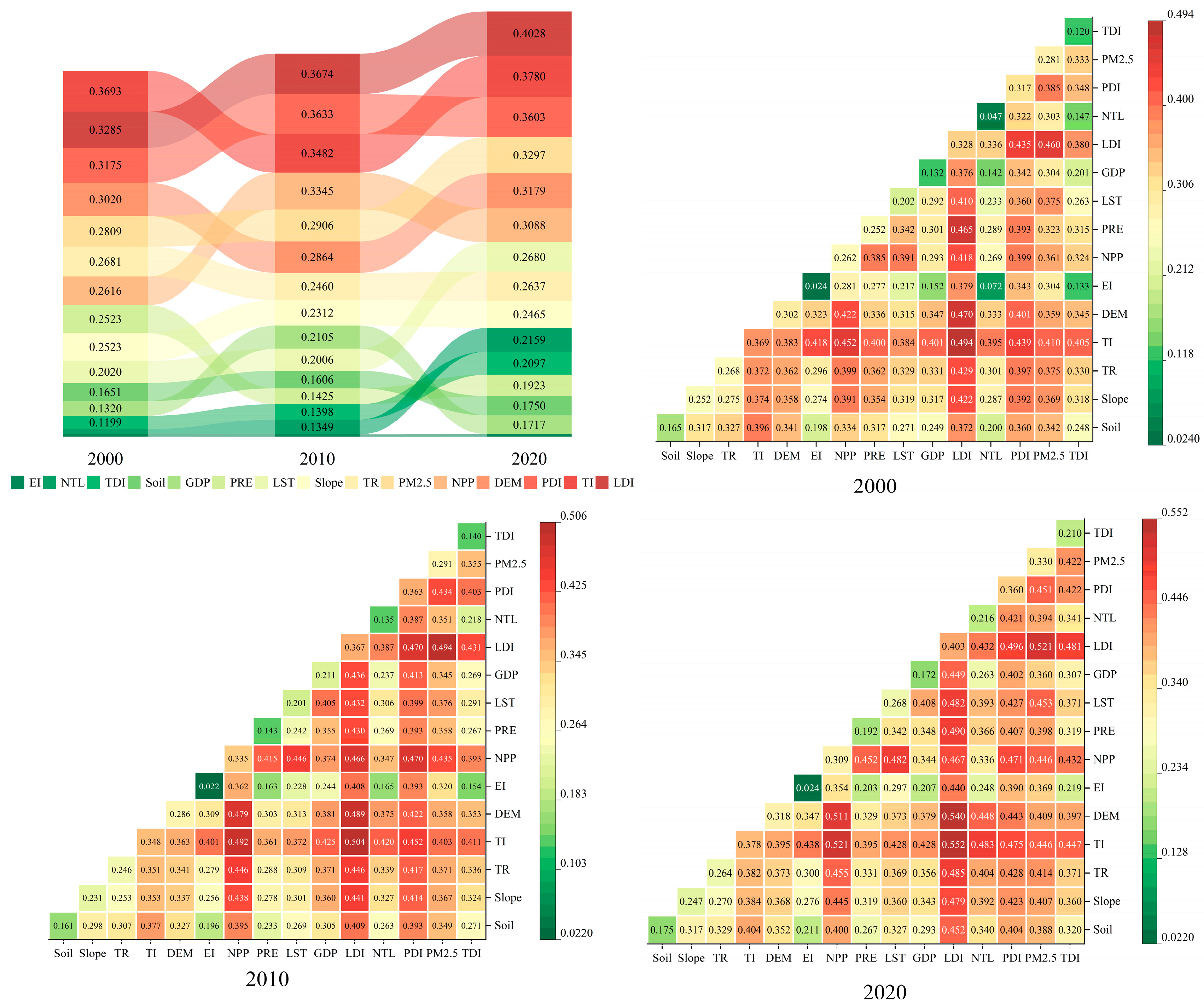
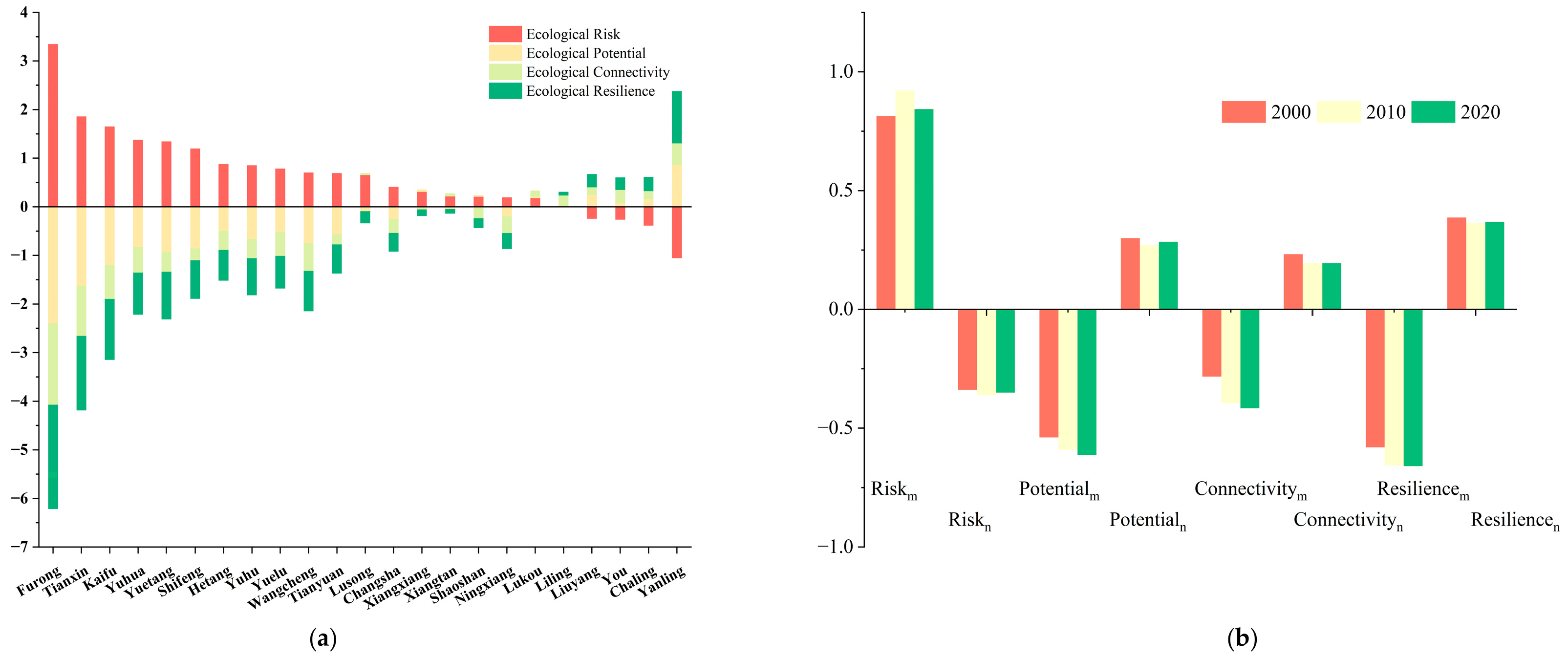
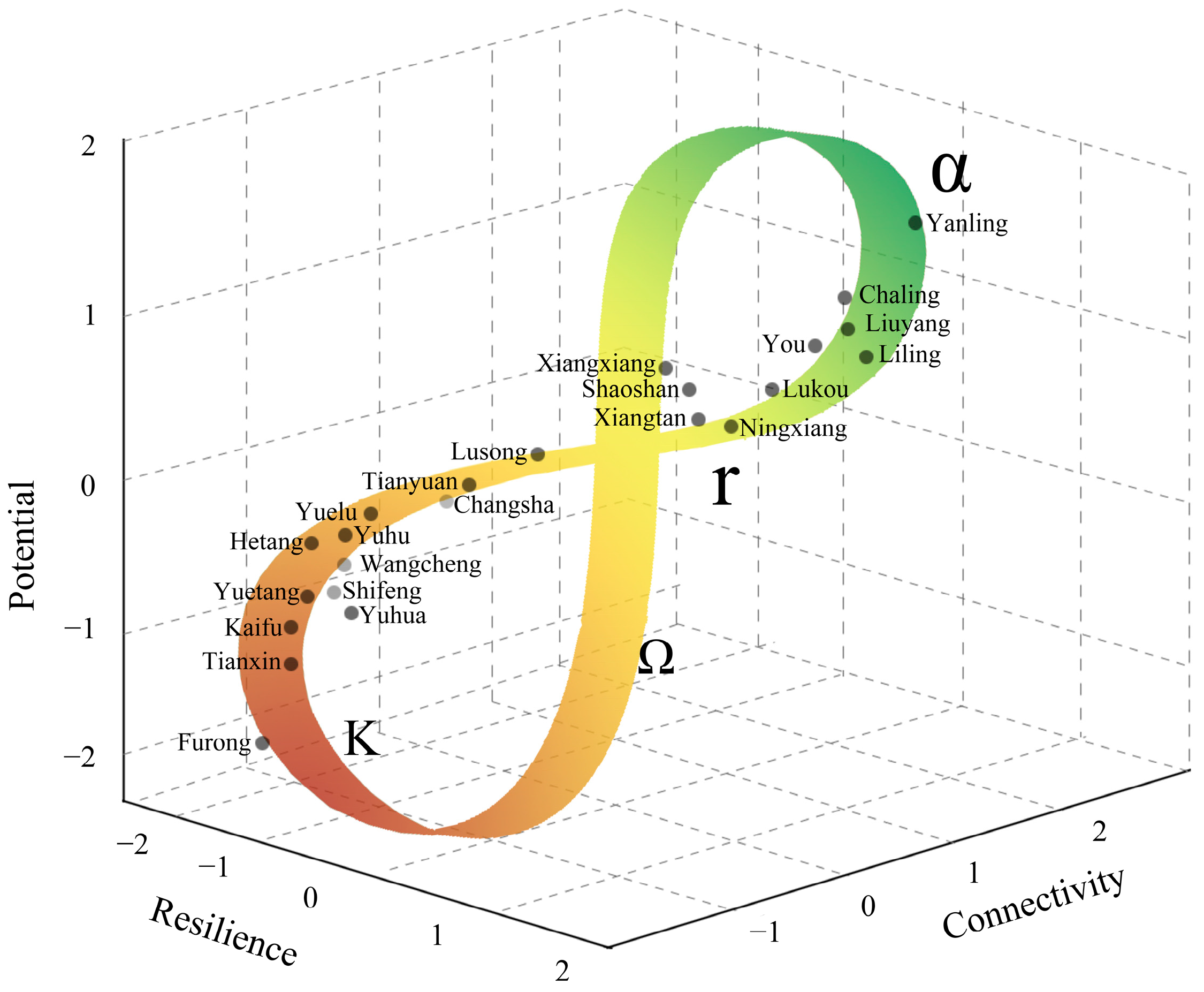


| Dataset | Data Source | Website Address | Resolution |
|---|---|---|---|
| Land cover | Resource and Environment Science and Data Center (2000, 2010, and 2020) | https://www.resdc.cn (accessed on 5 July 2024) | 30 m |
| GDP | https://www.resdc.cn (accessed on 24 July 2024) | 1000 m | |
| Precipitation | National Tibetan Plateau Data Center | https://data.tpdc.ac.cn (accessed on 25 August 2024) | 1000 m |
| Temperature | https://data.tpdc.ac.cn (accessed on 25 August 2024) | 1000 m | |
| FVC | https://data.tpdc.ac.cn (accessed on 31 July 2024) | 250 m | |
| PM2.5 | https://data.tpdc.ac.cn (accessed on 5 July 2024) | 1000 m | |
| LST | National Earth System Science Data Center | https://www.geodata.cn (accessed on 24 July 2024) | 1000 m |
| Soil type | https://www.geodata.cn (accessed on 26 August 2024) | - | |
| Nighttime light | https://www.geodata.cn (accessed on 24 July 2024) | 500 m | |
| Evapotranspiration | https://www.geodata.cn (accessed on 16 August 2024) | 1000 m | |
| NPP | https://www.geodata.cn (accessed on 13 August 2024) | 500 m | |
| NDVI | http://www.nesdc.org.cn (accessed on 23 July 2024) | 30 m | |
| Population density | World pop | https://hub.worldpop.org (accessed on 23 July 2024) | 100 m |
| Digital elevation model | Geospatial Data Cloud | http://www.gscloud.cn (accessed on 5 July 2024) | 30 m |
| Road | the National Road Traffic Network vector map of the Peking University Geographic Data Platform and National Catalog Service For Geographic Information | https://www.webmap.cn, https://geodata.pku.edu.cn/ (accessed on 5 August 2024) | - |
| Criterion Layer | Indicator | Attribute | CRITIC Weight | AHP Weight | Weight | Descriptions | References |
|---|---|---|---|---|---|---|---|
| Geographic Basis | Terrain location index | − | 0.0609 | 0.0198 | 0.0403 | (1) are the average elevation and slope in the region, respectively. | [44] |
| Topographic relief | − | 0.0324 | 0.036 | 0.0342 | \ | [44] | |
| Soil type | + | 0.0777 | 0.0652 | 0.0715 | Calcareous (rocky) soil and stony soil are 1; tide soil, yellow soil, and yellow-brown soil are 0.8; rice soil is 0.6; red soil is 0.4; mountain meadow soil and purple soil are 0.2; and other soils are 0. | [45] | |
| Landscape Patterns | Landscape disturbance index | + | 0.0590 | 0.0918 | 0.0754 | (2) E is the landscape disturbance index; P is the patch density; F is the landscape segmentation index; D is the landscape separateness index. | [20,46] |
| Spreading index | − | 0.1459 | 0.0406 | 0.0932 | \ | [47] | |
| Shannon diversity index | − | 0.1290 | 0.0304 | 0.0797 | \ | [47] | |
| NDVI | − | 0.0445 | 0.1067 | 0.0756 | \ | [48] | |
| Human activities | Population agglomeration pressure | + | 0.0378 | 0.0523 | 0.0451 | pd ≥ 1000 people/km2, PDI is 1; otherwise (3) PDI is population agglomeration pressure; pd is population density. | [49] |
| Land use pressure | + | 0.0792 | 0.0408 | 0.0600 | Construction land, unutilized land, cropland, grassland, water bodies, and forest land are, respectively, 1, 0.9, 0.5, 0.2, 0.1, and 0. | [44] | |
| Transportation pressure | + | 0.1076 | 0.1077 | 0.1076 | The pressure on the traffic network is assigned with different radius buffers according to different road classes. | [50,51] | |
| Economic pressure | + | 0.0187 | 0.0708 | 0.0448 | \ | [20] | |
| Air pollution pressure | + | 0.0780 | 0.0436 | 0.0608 | \ | [42] | |
| Electricity consumption Pressure | + | 0.0148 | 0.1017 | 0.0582 | \ | [48] | |
| Natural Disasters | Geologic disasters | + | 0.0545 | 0.0946 | 0.0745 | Measured by informativeness | [52] |
| Rain and flood disasters | + | 0.0237 | 0.0601 | 0.0419 | Measured by hazard factor and environment | [52] | |
| Surface thermal environment | + | 0.0363 | 0.0381 | 0.0372 | Characterized by surface temperature data | [48] |
| Level 1 Ecological Corridor | Level 2 Ecological Corridor | Level 3 Ecological Corridor | |||
|---|---|---|---|---|---|
| Buffer Distance (km) | Connectivity | Buffer Distance (km) | Connectivity | Buffer Distance (km) | Connectivity |
| 0–1 | 1 | 0–0.8 | 0.8 | 0–0.5 | 0.5 |
| 1–2 | 0.5 | 0.8–1.6 | 0.4 | 0.5–1 | 0.25 |
| 2–3 | 0.25 | 1.6–2.4 | 0.2 | 1–1.5 | 0.125 |
| >3 | 0 | >2.4 | 0 | >1.5 | 0 |
Disclaimer/Publisher’s Note: The statements, opinions and data contained in all publications are solely those of the individual author(s) and contributor(s) and not of MDPI and/or the editor(s). MDPI and/or the editor(s) disclaim responsibility for any injury to people or property resulting from any ideas, methods, instructions or products referred to in the content. |
© 2025 by the authors. Licensee MDPI, Basel, Switzerland. This article is an open access article distributed under the terms and conditions of the Creative Commons Attribution (CC BY) license (https://creativecommons.org/licenses/by/4.0/).
Share and Cite
Peng, H.; Lou, H.; Liu, Y.; He, Q.; Zhang, M.; Yang, Y. Spatial and Temporal Evolution Assessment of Landscape Ecological Resilience Based on Adaptive Cycling in Changsha–Zhuzhou–Xiangtan Urban Agglomeration, China. Land 2025, 14, 709. https://doi.org/10.3390/land14040709
Peng H, Lou H, Liu Y, He Q, Zhang M, Yang Y. Spatial and Temporal Evolution Assessment of Landscape Ecological Resilience Based on Adaptive Cycling in Changsha–Zhuzhou–Xiangtan Urban Agglomeration, China. Land. 2025; 14(4):709. https://doi.org/10.3390/land14040709
Chicago/Turabian StylePeng, Huaizhen, Huachao Lou, Yifan Liu, Qingying He, Maomao Zhang, and Ying Yang. 2025. "Spatial and Temporal Evolution Assessment of Landscape Ecological Resilience Based on Adaptive Cycling in Changsha–Zhuzhou–Xiangtan Urban Agglomeration, China" Land 14, no. 4: 709. https://doi.org/10.3390/land14040709
APA StylePeng, H., Lou, H., Liu, Y., He, Q., Zhang, M., & Yang, Y. (2025). Spatial and Temporal Evolution Assessment of Landscape Ecological Resilience Based on Adaptive Cycling in Changsha–Zhuzhou–Xiangtan Urban Agglomeration, China. Land, 14(4), 709. https://doi.org/10.3390/land14040709







